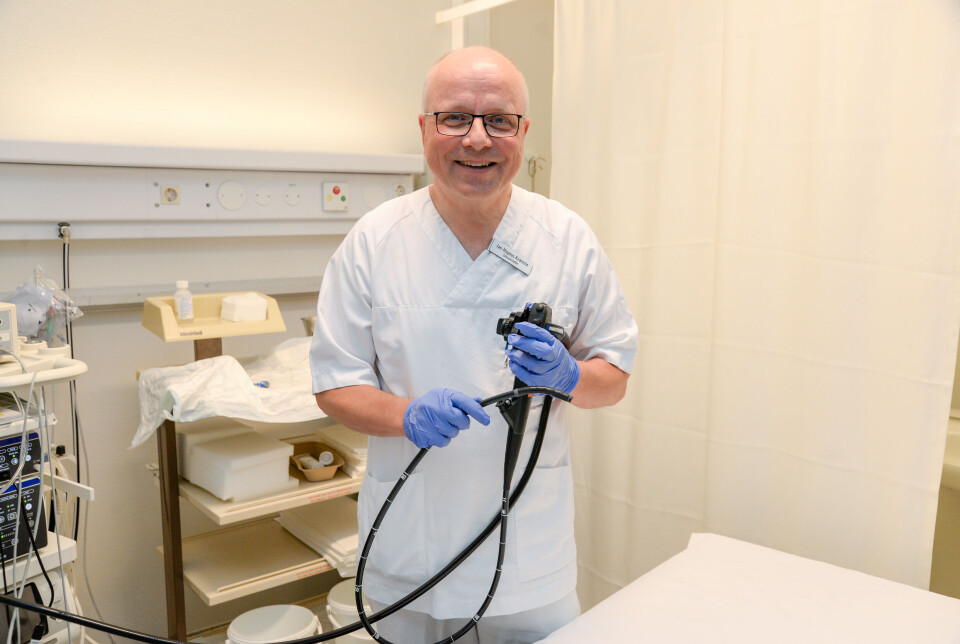
Large Norwegian study reveals celiac disease in many people who were unaware they had it
Researcher who led the study found it surprising that so many people were undiagnosed.
The Tromsø survey is a large survey that has monitored the health of the Northern Norwegian city's population for almost 50 years.
Now a third of the adult population in Tromsø has been examined for celiac disease.
Celiac disease is a chronic disease that causes a person to become ill from proteins found in wheat, barley and rye.
When someone with celiac disease eats food containing the protein gluten, the immune system reacts. Celiac leads to an inflammation that over time destroys the intestinal tract, which is important for absorbing nutrition.
Blood test and gastroscopy
Over 12 000 Tromsø residents had blood tests taken to detect celiac disease.
Those who tested positive for known antibodies in celiac disease were invited to undergo a gastroscopy examination that takes tissue samples from the small intestine.
“As far as we know, this is the largest published screening study to date on celiac disease using both a blood test and a biopsy,” says Jan-Magnus Kvamme, a researcher at UiT The Arctic University of Norway who led the study.
Kvamme is also section chief of the Digestion Section at the University Hospital of North Norway in Tromsø.
The special feature of this study is that the researchers used a method called immunohistochemistry on the tissue samples from the small intestine.
This method provides a more precise diagnosis, and it also makes it possible to find patients with potential celiac disease, such as those who have a less serious illness or who are on the way to developing the illness.
A surprising number
As many as 75 per cent of the approximately 190 people in whom celiac disease was discovered after these examinations did not previously have the diagnosis.
The vast majority of these patients had clear changes in their small intestine.
“I was surprised that such a large proportion of the patients were previously undiagnosed,” says Kvamme.
He believes that one possible reason the patients had not been to the doctor and received the diagnosis is that many of them did not have the typical stomach and intestinal complaints.
“In addition, the disease creeps up on patients. A lot of people also reduce the amount of bread they consume as they age. Then the problems become more diffuse and you get used to them. Having a little stomach pain can become a normal condition.”
Only when the patients receive a diagnosis and try a gluten-free diet do they become aware of how they’ve been feeling and what it’s like to be healthy, he says.
- RELATED: Another Norwegian study based on the Trøndelag Health Study (HUNT) also found a lot of undiagnosed celiac disease, more about this in You may have celiac disease without knowing it
Not going to the doctor can have consequences
Kvamme believes that going a long time without treating celiac disease can have consequences.
Most importantly, patients are not resolving their stomach and intestinal problems.
“Most studies show slightly increased mortality in people with untreated celiac disease. The disease affects patients in a negative way. They may have less energy and be more tired. They may suffer from a lack of nutrients which can cause low iron levels and bone fragility,” Kvamme says.
Follow-up questionnaires
At the beginning of the study and after a year and a half of a gluten-free diet, patients who were diagnosed with celiac disease at the screening were asked to respond to two questionnaires. One was about stomach problems and the other about quality of life.
Meanwhile, those diagnosed with celiac disease had received guidance on how to adapt their eating habits to avoid gluten.
Few other studies have tried a gluten-free diet in patients who were diagnosed with celiac disease during screening.
“We found that a gluten-free diet improved symptoms that the patients had no idea were due to their celiac disease,” says Kvamme.
Most people improved
Most of the patients, 76 per cent, had fewer problems with their stomach and intestines after they started a gluten-free diet.
Increased energy was reported by 58 per cent.
The researchers do not know why not everyone improved from the gluten-free diet.
“The immune system may react differently in different people,” says Kvamme.
It could also be that the intestine was still not healthy when researchers examined the patients after one to two years.
They know from other studies that many newly diagnosed celiac patients can take a long time, perhaps several years, to restore a healthy mucosa.
Autoimmune disease
Celiac disease is an autoimmune disease. This means that the immune system begins to attack cells and tissues in the same body that it is supposed to defend.
Norwegian research has contributed to uncovering the mechanisms of celiac disease. ScienceNorway.no has written about this previously.
Even though scientists know a lot about the disease, there is still a lot they don't fully understand.
Heredity plays a role
They know that the disease is partly hereditary. Everyone with celiac disease has special tissue types called HLA-DQ2 or HLA-DQ8.
But even if you are born with a genetic predisposition to celiac disease, it is far from certain that you will develop the disease.
Celiac patients are born with a completely normal immune system. But at some point, the immune system may suddenly attack gluten. In most cases this happens in childhood, but in many cases the diagnosis is only made in adulthood.
Once the immune reaction has started, the disease is there – and you have it for life.
Reference:
Jan-Magnus Kvamme mfl.: Population-based screening for celiac disease reveals that the majority of patients are undiagnosed and improve on a gluten-free diet.Scientific Reports, 2022. Doi.org/10.1038/s41598-022-16705-2
———
Read the Norwegian version of this article at forskning.no
------

































